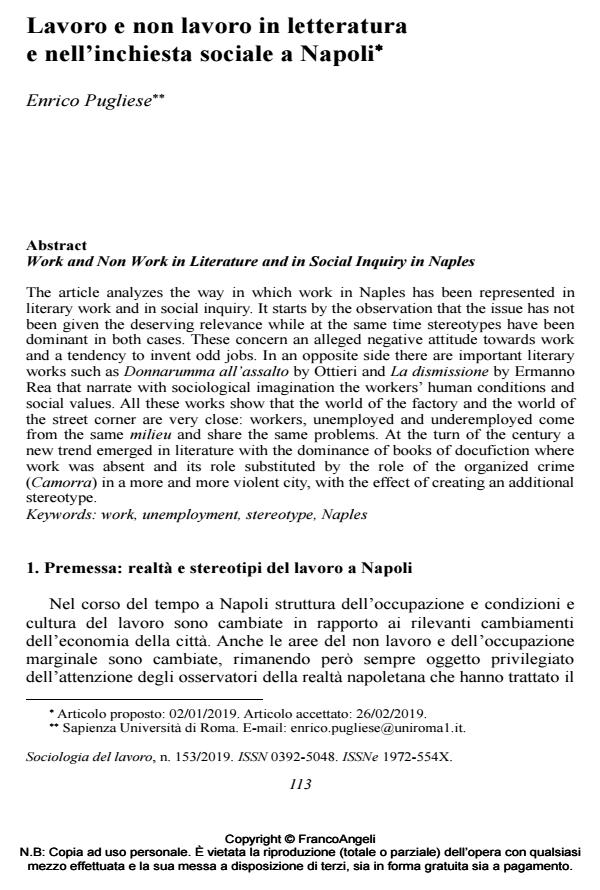Work and Non Work in Literature and in Social Inquiry in Naples
Journal title SOCIOLOGIA DEL LAVORO
Author/s Enrico Pugliese
Publishing Year 2019 Issue 2019/153
Language Italian Pages 16 P. 113-128 File size 274 KB
DOI 10.3280/SL2019-153007
DOI is like a bar code for intellectual property: to have more infomation
click here
Below, you can see the article first page
If you want to buy this article in PDF format, you can do it, following the instructions to buy download credits

FrancoAngeli is member of Publishers International Linking Association, Inc (PILA), a not-for-profit association which run the CrossRef service enabling links to and from online scholarly content.
The article analyzes the way in which work in Naples has been represented in literary work and in social inquiry. It starts by the observation that the issue has not been given the deserving relevance while at the same time stereotypes have been dominant in both cases. These concern an alleged negative attitude towards work and a tendency to invent odd jobs. In an opposite side there are important literary works such as Donnarumma all’assalto by Ottieri and La dismissione by Ermanno Rea that narrate with sociological imagination the workers’ human conditions and social values. All these works show that the world of the factory and the world of the street corner are very close: workers, unemployed and underemployed come from the same milieu and share the same problems. At the turn of the century a new trend emerged in literature with the dominance of books of docufiction where work was absent and its role substituted by the role of the organized crime (Camorra) in a more and more violent city, with the effect of creating an additional stereotype.
Keywords: Work, unemployment, stereotype, Naples
- Allum P. (1973). Politics and Society in Post-war Naples. Cambridge: Cambridge University Press (trad. it.: Potere e società a Napoli nel dopoguerra. Torino: Einaudi, 1975).
- Anselmo M. e Marcello P. (2017). Storie di magliari. Mestieranti napoletani sulle strade d’Europa. Roma: Donzelli.
- Bernari C. (1934). Tre operai. Milano: Rizzoli.
- Ceronetti G. (1985). Albergo Italia. Torino: Einaudi.
- Collins R. (2009). Gomorrah: A Personal Journey into the Violent International Empire of Naples’ Organized Crime System. Contemporary Sociology: A Journal of Reviews, 38, 6: 516-521. DOI: 10.1177/009430610903800603
- Dal Lago A. (2010). Eroi di carta. Il caso Gomorra e altre epopee. Roma: Manifestolibri.
- De Bourcard F., a cura di (1955). Usi e costumi di Napoli e contorni. Milano: Longanesi & C.
- Dupaty C.-M.-J.-B. (1788). Lettres sur l’Italie en 1785. Paris: De Senne (trad. it.: in Ramondino F. e Müller A.F., Dadapolis. Caleidoscopio napoletano. Torino: Einaudi, 1989).
- Ferrante E. (2011). L’amica geniale. Roma: e/o.
- Goethe J.W. (1983). Lettere da Napoli. Napoli: Guida.
- Lewis N. (1993). Napoli’44. Milano: Adelphi.
- Malaparte C. (1949). La pelle. Roma-Milano: Aria d’Italia.
- Mallet S. (1966). La nuova classe operaia. Torino: Einaudi.
- Orientale Caputo G. (2012). Come una danza immobile. Tre anni di disoccupazione, lavoro nero e povertà a Napoli. Milano: Ledizioni.
- Orientale Caputo G. (2013). La precarietà dei giovani a Napoli tra disoccupazione e cattiva occupazione. La Critica Sociologica, XLVII, 188, 4: 57-70.
- Ortese A.M. (1999). Il mare non bagna Napoli. Milano: Adelphi.
- Ottieri O. (1959). Donnarumma all’assalto. Milano: Bompiani.
- Ramondino F., a cura di (1977). Napoli, i disoccupati organizzati: i protagonisti raccontano. Milano: Feltrinelli.
- Ramondino F., a cura di (1998). Ci dicevano analfabeti. Il movimento dei disoccupati napoletani degli anni ’70. Lecce: Argo.
- Ramondino F. e Müller A.F. (1989). Dadapolis. Caleidoscopio napoletano. Torino: Einaudi.
- Rea E. (1995). Mistero napoletano. Torino: Einaudi.
- Rea E. (2002). La dismissione. Milano: Rizzoli.
- Rea E. (2007). Napoli Ferrovia. Milano: Rizzoli.
- Rosa R. (2017). Lo sparo nella notte. Sulla morte di Davide Bifolco, ucciso da un carabiniere. Napoli: Napoli Monitor.
- Saviano R. (2006). Gomorra. Viaggio nell’impero economico e nel sogno di dominio della camorra. Milano: Mondadori.
- Serao M. (1994). Il ventre di Napoli (ieri e… oggi). Napoli: Luca Torre Editore.
- Sohn-Rethel A. (1926). Das Ideal des Kaputten. Über neapolitanische Technik. Frankfurter Zeitung, 21 marzo (trad. it.: in Ramondino F. e Müller A.F., Dadapolis. Caleidoscopio napoletano. Torino: Einaudi, 1989).
Enrico Pugliese, Lavoro e non lavoro in letteratura e nell’inchiesta sociale a Napoli in "SOCIOLOGIA DEL LAVORO " 153/2019, pp 113-128, DOI: 10.3280/SL2019-153007